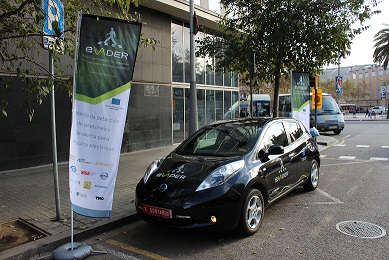Silent e-cars speak up

Related topics
Innovation Transport Societal Challenges Smart, green and integrated transport Austria France Germany Netherlands Spain United Kingdomdate: 21/05/2015
Project: eVADER: Electric Vehicle Alert for Detec...
acronym: eVADER
See also: CORDIS
The eVADER project has developed a prototype of an intelligent alert system for electric and hybrid cars. This system detects pedestrians and other vulnerable road users at risk of collision and directs a warning sound specifically at them.
The sound is optimised to be clearly audible to the targeted individuals, but barely perceptible to other road users. “We only warn the person in danger,” says project coordinator Juan J. García of Applus IDIADA in Spain.
The optimal sound volume is determined for each warning and depends on the level of background noise, ensuring that the alert is loud enough, but no louder than it needs to be. The timbre of the sound was optimised for the best possible compromise between high detectability and low noise pollution.
Less noise, more safety
While e-cars are not inaudible, they produce far less noise than conventional cars, particularly at very low speeds. “The main objective of eVADER was to develop an AVAS — acoustic vehicle alert system — to address the safety issue while controlling the amount of noise that is introduced into the environment,” García explains.
“You can’t have electric vehicles that are very quiet and then put on speakers and start making an awful lot of noise,” he notes. “We decided that the solution would be a directional system, which is basically an acoustic source that radiates sound mainly in the direction where you want this sound to travel.”
The research involved major car manufacturers and automotive suppliers, universities and research institutes as well as the European Blind Union, which supplied the input of road users who are particularly reliant on sound.
Directional sound is produced by arrays of loudspeakers that boost the sound in a specific direction and cancel it out in others, García explains. eVADER developed a prototype of an intelligent system that detects at-risk road users by means of the camera and radar equipment already available in many cars, which is likely to become increasingly common. The information is fed into a control system designed by eVADER to enable this equipment to swap information with the associated acoustic system.
The warning sound is emitted by six loudspeakers at the front of the vehicle. The level of ambient noise, determined with microphones, is factored in to ensure that the sound is clearly audible at the location of the at-risk individual, but no louder than necessary. Other road users will hardly hear it at all.
To guarantee maximum safety, the targeted warning is always combined with a low-level omnidirectional sound. Depending on future legislation, a different sound could also be integrated, to indicate that the car is reversing.
The alert e-car
Most of the underlying technologies already existed, says García, but they were disconnected from each other. “We recognised that we could assemble them and produce an integrated system that is more intelligent than the average vehicle, in the sense that it can not only see, but also hear,” he notes. “We need this hearing capability to adjust the sound to the level of background noise.”
The controller allows the car to process this “sensory” information and respond accordingly. “We have an acoustic source able to talk to the camera and say ‘Where is the pedestrian I should warn?’, and then the sound is directed at this person,” says García. Tests involving both blind and sighted volunteers have been very successful, he reports.
It’s a sophisticated system that can be scaled back to develop inexpensive commercial applications, says García. Several of the required components are already available on many cars, he notes, and the additional electronics and sensors are increasingly affordable.
What the future holds for such systems mainly depends on the way the legislation will evolve, García concludes. While cars should not be entirely silent, he notes, the ability to project directional sound as necessary means that the required minimum noise level could be lowered.
The rules could also be refined to reflect the possibility of generating highly detectable warning signals with low acoustic impact, he adds. Rush-hour traffic could become blissfully silent without putting vulnerable road users at additional risk — provided they don't wear headphones.
